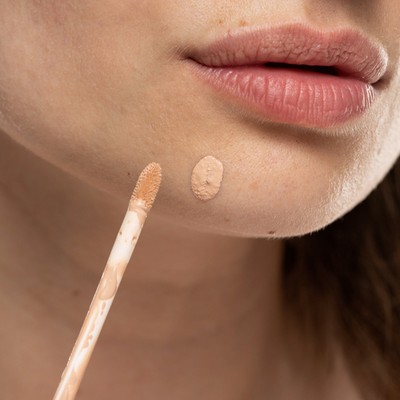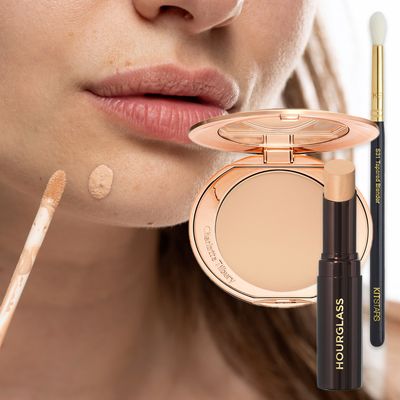

Make-Up Advice For Acne-Prone Skin
All products on this page have been selected by our editorial team, however we may make commission on some products.
Maintain The Right Balance
“When it comes to applying make-up to acne prone skin, it can be difficult to find the right balance. You want decent coverage, but a look that still feels fresh not cakey. In some ways, less is always more. You don’t want to suffocate the skin or dull its appearance. The trick is to unify and even out the skin tone, before applying heavier formulas only to the areas that need it most. Make sure you highlight the clear areas of your skin to enhance the look of your overall make-up.” – Jessica Kell, Make-Up Artist
Avoid Formulas That Feel Thick
“Heavy coverage may create the illusion of even-toned skin from a distance, but it basically acts like cement clogging up your pores. This then traps oil and bacteria, along with old dead skin cells – and the pimples reappear. Instead, try mineral-based make-up. These formulas contain ingredients like silica, titanium dioxide and zinc oxide, which absorb oil and hide redness without irritating the skin. Look out for dimethicone on the ingredients list, too. It conceals redness while smoothing out uneven skin.” – Dr Anita Sturnham, GP & specialist in dermatology
Prep Skin The Right Way
“If you’re dealing with any sort of breakout, the trick is to prime the skin to ensure a squeaky-clean base. As you build your make-up, you want to use very light layers to stop too much product sitting in your pores, so starting with zero excess oil on your skin helps. Revive’s Foaming Cleanser is great at gently cleansing skin without stripping or drying it out. Use it with a clean cotton or microfibre cloth for some gentle exfoliation. When you your prime skin, avoid using anything that has illumination or a pearlescent finish to it. These can be tempting if you want to combat dullness but you should be using primers that are light and mattifying. I rate La Roche-Posay’s Effaclar Mat.” – Jessica
Choose Non-Comedogenic Products
“When choosing make-up for acne-prone skin, look for those that are marked as non-comedogenic. This literally means ‘will not block pores’, so you can be confident they’re oil-free and suitable for your complexion. It’s worth looking out for gel-based textures that add hydration, as these will nourish and support barrier function for healthier skin overall.” – Dr Anjali Mahto, consultant dermatologist & author of The Skincare Bible
“Hourglass’s Immaculate Liquid Powder Foundation is a great example of a base that’s non-comedogenic and hydrating. It contains cashmere kaolinite clay, which regulates oil control by drawing impurities out of your pores.” – Anita
Stay Light
“I’m often asked how to ensure you’re not making the issue worse with make-up. So many of us fall into a trap of thinking heavier coverage is better to conceal everything, but this can be so aggravating. Avoid ‘heavier’ and instead think ‘more pigmented’. The more concentrated your product is, the less of it you need, which makes a real difference to the overall finish. My advice would be to use a little of NARS’s Light Reflecting Foundation, then follow with Vichy’s Dermablend Concealer, or Hourglass’s Hidden Corrective formula for smooth, even coverage that doesn’t suffocate.” – Jessica
Shrink Spots With Concealer
“Look for concealers with skincare actives such as salicylic acid, zinc, sulphur, menthol and kaolin clay. These ingredients can relieve breakouts while covering blemishes and there are so many on the market. An extra tip is to try massaging your skin with an ice cube just before bed for about 15 seconds. This will shrink inflammation ready for when you apply your make-up in the morning.” – Anita
Watch Out For Synthetic Ingredients
“Check make-up products that list fragrance, perfume or parfum on the ingredients label. These essential oils aren’t the friend of anyone suffering with adult acne – they can really irritate already inflamed skin. Oils with a prevalence of saturated fatty acids should be avoided too: these include coconut, cocoa, shea, mango and cupuacu oil. Also, avoid any products that include sodium lauryl sulphate, which is commonly found in cleansers. These can damage the skin’s protective barrier, resulting in further irritation.” – Dr Tiina Meder, dermatologist & founder of Meder Beauty
Focus On The Clearest Areas Of Skin
“Whenever I do make-up for someone suffering with acne, the first thing I do is look for the clearest areas. Even if you are going through a large flare-up, there will always be patches of skin that need less attention, so focus on using as little product as possible there. Use a very light moisturiser that gently plumps the skin as a base for foundation. The SUQQU Aquafons Replenishing Fluid delivers soothing moisture, but never feels heavy under make-up. Start by applying a light layer of foundation down the centre of your face and blend it out. At this stage, it’s all about even coverage, so don’t worry about trying to cover or conceal anything yet. Then, go back in for a second layer just over the areas where you need it the most. I like to mix a little bit of foundation with a heavy concealer and apply it over any specific areas with a fluffy eyeshadow brush. This just helps to blend out all the edges. Then you can go in with a tiny eyeliner brush and just add the concealer on top of any redness that’s still showing through. Finish with a translucent powder, applying it only to the areas that need the most coverage. Apply it with a flat foundation brush, really pushing it into the skin to hold make-up in place. Charlotte Tilbury’s Airbrush Powder is great for this.” – Jessica
Try Colour Correctors
“Colour correctors are a handy tool for acne sufferers. Try using them underneath your base make-up. Green-toned correctors neutralise redness, while peachy tones will cancel out pigmentation and dark marks. Vichy colour correctors are a brilliant option and lend great coverage. They’re gentle and kind to the skin, too.” – Anjali
“Look out for redness-reducing primers, too – just don’t overdo it. Primers with a slight green hint to them will help neutralise inflammation – just take a light-handed approach so you don’t get a chalky effect or alter the colour of your foundation. The Clinique Redness Solutions Daily Protective Base SPF15 works particularly well, and it can be easily sheered out. I often recommend mixing a matte concealer into a medium coverage foundation, too. The mix of textures will add pigment to your foundation without overloading it. Try mixing The Ordinary’s Concealer with your foundation – there’s an array of shades and undertones to choose from.” – Jessica
Know How To Use Your Tools
"Clean make-up tools are key. Sponges can be great for building up sheer layers, but they can also harbour lots of bacteria that harms skin. If you are thoroughly washing it with detergent immediately after every use, fine, but the likelihood is slim, so I suggest using brushes instead. However, they too must be kept clean. Dense foundation brushes are great to buff in the first layer of foundation, but a flat foundation brush is better to pat each layer on without disturbing the one beneath. Try the Sigma F60 Foundation Brush for seamless application. It’s also best to opt for eyeshadow brushes that will blend everything together seamlessly. The Kit Stars Vegan Tapered Blender Brush S31 is my choice. Don’t use your fingers – even if they’re scrupulously clean, they can still transfer oil and the heat from your hands can disturb existing make-up, too.” – Jessica
“It’s one thing having the right make-up and formulas, but none of this matters if you’re not cleaning your tools. Brushes and sponges are a breeding ground for bacteria, so cleaning them every day is essential if you have acne. Rinse them with soap, and don’t share them with others. It also goes without saying that you should be cleansing thoroughly morning and evening to remove any make-up you do wear.” – Dr Anjali
Finally, Be Careful With Highlighter
“Don’t go mad with highlighter once you’ve finished concealing your skin. All illuminating products show up the natural texture of your skin, so don’t be tempted to apply any highlighter to any problem areas – even once you’ve concealed them.” – Jessica
For more make-up advice & tips, follow @JessicaKMakeup
To book a skin appointment or for more advice, visit @Meder_Beauty, @AnjaliMahto & @DrAjSturnham
The Expert Picks For Acne-Prone Skin...
DISCLAIMER: We endeavour to always credit the correct original source of every image we use. If you think a credit may be incorrect, please contact us at info@sheerluxe.com.











